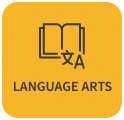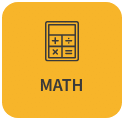- Ontario:
- Math
- Language Arts
- Social Studies
- Science
Ontario
Skills available for Ontario Grade 6 Math Curriculum (2020)
Expectations are in black and skills are in blue. Click on the name of the skill to practice that skill.
Please check back as we are always adding more content!
6.B Number
6.B1 Number Sense
Rational Numbers
6.B1.1 read and represent whole numbers up to and including one million, using appropriate tools and strategies, and describe various ways they are used in everyday life
Digital Resources
• Representing Numbers to 1 000 000
Printable Worksheets
• Building Numbers in the Place Value Chart
• Decomposing Numbers to 1 000 000
• Fill in the Place Value Chart
• Marking Number Lines to 1 000 000
• Reading Numbers to 1 000 000
6.B1.2 read and represent integers, using a variety of tools and strategies, including horizontal and vertical number lines
Digital Resources
Printable Worksheets
• Exploring Positive and Negative Integers
6.B1.3 compare and order integers, decimal numbers, and fractions, separately and in combination, in various contexts
Digital Resources
Printable Worksheets
• Comparing and Ordering Numbers
Fractions, Decimals, and Percents
6.B1.4 read, represent, compare, and order decimal numbers up to thousandths, in various contexts
Digital Resources
• Reading and Representing Decimals
Printable Worksheets
• Reading and Representing Decimals
• Matching Decimals to Their Written Form
• Comparing Decimals Using Models
6.B1.5 round decimal numbers, both terminating and repeating, to the nearest tenth, hundredth, or whole number, as applicable, in various contexts
6.B1.6 describe relationships and show equivalences among fractions and decimal numbers up to thousandths, using appropriate tools and drawings, in various contexts
Digital Resources
• Reading and Writing Decimal Thousandths
• Decimal Thousandths on a Grid
Printable Worksheets
6.B2 Operations
Properties and Relationships
6.B2.1 use the properties of operations, and the relationships between operations, to solve problems involving whole numbers, decimal numbers, fractions, ratios, rates, and whole number percents, including those requiring multiple steps or multiple operations
Math Facts
6.B2.2 understand the divisibility rules and use them to determine whether numbers are divisible by 2, 3, 4, 5, 6, 8, 9, and 10
Mental Math
6.B2.3 use mental math strategies to calculate percents of whole numbers, including 1%, 5%, 10%, 15%, 25%, and 50%, and explain the strategies used
Addition and Subtraction
6.B2.4 represent and solve problems involving the addition and subtraction of whole numbers and decimal numbers, using estimation and algorithms
Digital Resources
Printable Worksheets
• Three-Digit Addition With Regrouping
• Three-Digit Addition Without Regrouping
• Math Riddle: Three-Digit Addition With Regrouping
• Math Riddle: Three-Digit Addition Without Regrouping
• Three-Digit Subtraction with Regrouping
• Three-Digit Subtraction Without Regrouping
• Math Riddle: Three-Digit Subtraction Without Regrouping
6.B2.5 add and subtract fractions with like and unlike denominators, using appropriate tools, in various contexts
Digital Resources
Printable Worksheets
Multiplication and Division
6.B2.6 represent composite numbers as a product of their prime factors, including through the use of factor trees
Digital Resources
• Identifying Prime and Composite Numbers
Printable Worksheets
• Identifying Prime and Composite Numbers
• Finding the Greatest Common Factor
• Exploring Prime Factorization
6.B2.7 represent and solve problems involving the multiplication of three-digit whole numbers by decimal tenths, using algorithms
6.B2.8 represent and solve problems involving the division of three-digit whole numbers by decimal tenths, using appropriate tools, strategies, and algorithms, and expressing remainders as appropriate
6.B2.9 multiply whole numbers by proper fractions, using appropriate tools and strategies
Digital Resources
Printable Worksheets
6.B2.10 divide whole numbers by proper fractions, using appropriate tools and strategies
Digital Resources
Printable Worksheets
6.B2.11 represent and solve problems involving the division of decimal numbers up to thousandths by whole numbers up to 10, using appropriate tools and strategies
Digital Resources
Printable Worksheets
6.B2.12 solve problems involving ratios, including percents and rates, using appropriate tools and strategies
Digital Resources
Printable Worksheets
6.C Algebra
6.C1 Patterns and Relationships
Patterns
6.C1.1 identify and describe repeating, growing, and shrinking patterns, including patterns found in real-life contexts, and specify which growing patterns are linear
Digital Resources
Printable Worksheets
6.C1.2 create and translate repeating, growing, and shrinking patterns using various representations, including tables of values, graphs, and, for linear growing patterns, algebraic expressions and equations
Digital Resources
Printable Worksheets
6.C1.3 determine pattern rules and use them to extend patterns, make and justify predictions, and identify missing elements in repeating, growing, and shrinking patterns, and use algebraic representations of the pattern rules to solve for unknown values in linear growing patterns
Digital Resources
Printable Worksheets
6.C1.4 create and describe patterns to illustrate relationships among whole numbers and decimal numbers
Digital Resources
Printable Worksheets
6.C2 Equations and Inequalities
Variables and Expressions
6.C2.1 add monomials with a degree of 1 that involve whole numbers, using tools
6.C2.2 evaluate algebraic expressions that involve whole numbers and decimal tenths
Equalities and Inequalities
6.C2.3 solve equations that involve multiple terms and whole numbers in various contexts, and verify solutions
Digital Resources
Printable Worksheets
• Algebraic Equations with Variables on Both Sides
6.C2.4 solve inequalities that involve two operations and whole numbers up to 100, and verify and graph the solutions
Digital Resources
Printable Worksheets
3.C3 Coding
Coding Skills
6.C3.1 solve problems and create computational representations of mathematical situations by writing and executing efficient code, including code that involves conditional statements and other control structures
6.C3.2 read and alter existing code, including code that involves conditional statements and other control structures, and describe how changes to the code affect the outcomes and the efficiency of the code
6.D Data
6.D1 Data Literacy
Data Collection and Organization
6.D1.1 describe the difference between discrete and continuous data, and provide examples of each
Digital Resources
Printable Worksheets
6.D1.2 collect qualitative data and discrete and continuous quantitative data to answer questions of interest about a population, and organize the sets of data as appropriate, including using intervals
Data Visualization
6.D1.3 select from among a variety of graphs, including histograms and broken-line graphs, the type of graph best suited to represent various sets of data; display the data in the graphs with proper sources, titles, and labels, and appropriate scales; and justify their choice of graphs
6.D1.4 create an infographic about a data set, representing the data in appropriate ways, including in tables, histograms, and broken-line graphs, and incorporating any other relevant information that helps to tell a story about the data
Digital Resources
Printable Worksheets
• Constructing A Double Bar Graph – Set 1
• Constructing A Double Bar Graph – Set 2
• Constructing Horizontal Bar Graphs – Set 1
• Constructing Horizontal Bar Graphs – Set 2
Data Analysis
6.D1.5 determine the range as a measure of spread and the measures of central tendency for various data sets, and use this information to compare two or more data sets
Digital Resources
Printable Worksheets
6.D1.6 analyse different sets of data presented in various ways, including in histograms and broken-line graphs and in misleading graphs, by asking and answering questions about the data, challenging preconceived notions, and drawing conclusions, then make convincing arguments and informed decisions
Digital Resources
Printable Worksheets
• Reading Double Bar Graphs – Set 1
• Reading Double Bar Graphs – Set 2
• Reading Double Bar Graphs – Set 3
• Thinking About Misleading Graphs
• Reading Horizontal Graphs – Set 1
• Reading Horizontal Graphs – Set 2
• Reading Tally Charts – Set 1
• Reading Tally Charts – Set 2
• Reading Circle Graphs – Set 1
• Reading Circle Graphs – Set 2
• Reading Circle Graphs – Set 3
• Reading Circle Graphs – Set 4
• Reading Circle Graphs – Set 5
• TEST: Reading Circle Graphs – Set 1
6.D2 Probability
Probability
6.D2.1 use fractions, decimals, and percents to express the probability of events happening, represent this probability on a probability line, and use it to make predictions and informed decisions
6.D2.2 determine and compare the theoretical and experimental probabilities of two independent events happening
6.E Spatial Sense
6.E1 Geometric and Spatial Reasoning
Geometric Reasoning
6.E1.1 create lists of the geometric properties of various types of quadrilaterals, including the properties of the diagonals, rotational symmetry, and line symmetry
Digital Resources
• Properties of Quadrilaterals
Printable Worksheets
• Identify Properties of Quadrilaterals
• Matching Properties to Quadrilaterals
6.E1.2 construct three-dimensional objects when given their top, front, and side views
Location and Movement
6.E1.3 plot and read coordinates in all four quadrants of a Cartesian plane, and describe the translations that move a point from one coordinate to another
Digital Resources
Printable Worksheets
6.E1.4 describe and perform combinations of translations, reflections, and rotations up to 360° on a grid, and predict the results of these transformations
Digital Resources
Printable Worksheets
6.E2 Measurement
The Metric System
6.E2.1 measure length, area, mass, and capacity using the appropriate metric units, and solve problems that require converting smaller units to larger ones and vice versa
Digital Resources
Printable Worksheets
Angles
6.E2.2 use a protractor to measure and construct angles up to 360°, and state the relationship between angles that are measured clockwise and those that are measured counterclockwise
6.E2.3 use the properties of supplementary angles, complementary angles, opposite angles, and interior and exterior angles to solve for unknown angle measures
Digital Resources
• Interior Angles of Triangles
• Interior Angles of Quadrilaterals
Printable Worksheets
• Interior Angles of Triangles
Area and Surface Area
6.E2.4 determine the areas of trapezoids, rhombuses, kites, and composite polygons by decomposing them into shapes with known areas
Digital Resources
Printable Worksheets
• Area of Rectangles and Squares
• Finding the Area of a Trapezoid
• Finding the Area of a Rhombus
• Decomposing Composite Shapes – Set 1
• Decomposing Composite Shapes – Set 2
6.E2.5 create and use nets to demonstrate the relationship between the faces of prisms and pyramids and their surface areas
Digital Resources
Printable Worksheets
• Identifying Prisms and Pyramids
6.E2.6 determine the surface areas of prisms and pyramids by calculating the areas of their two-dimensional faces and adding them together
Digital Resources
Printable Worksheets
• Finding the Surface Area of Prisms
• Thinking About – Surface Area









